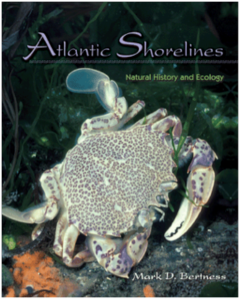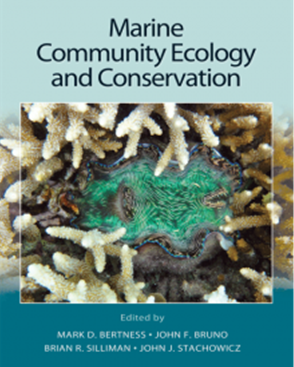RESEARCH INTERESTS
I am interested in marine coastal ecology and conservation. My research focuses on understanding the processes that structure natural communities and applying this knowledge to informing coastal conservation. I am also interested in the role of positive interactions in community organization and gaining the mechanistic understanding of community assembly rules necessary to predict and remediate the consequences of human disturbances. I work with coastal communities in New England, but I am also interested in marine biogeography, tropical ecosystems and have worked extensively on South American shorelines.
CURRENT RESEARCH PROJECTS
Causes and Consequences of Salt Marsh Die-Off
Over the past decade it has become clear that human disturbances are leading to the die-off of western Atlantic salt marshes from Canada to Argentina. While the players differ geographically, the generic story is that in salt marshes, once controlled by bottom-up physical factors, human disturbances are shifting these ecosystems to top-down consumer control, often with catastrophic results.
In New England salt marsh creek-bank die-off was first reported in 2002. We have shown that these die-offs are being driven by herbivory by the native, nocturnal burrowing crab, Sesarma reticulatum (Holdredge et al 2009). Sesarma live in extensive communal burrows and at high densities are capable of entirely denuding creek banks of the cordgrass that builds and maintains marshes. Historical reconstructions from archived aerial photographs have revealed that die-offs have been forming and expanding on Cape Cod for 30 years, and our field experiments and multi-site sampling has shown that the establishment and expansion of die-offs are driven by predator depletion. Reduced predation has triggered increased Sesarma abundance and herbivory, which in turn has led to the dramatic expansion of die-offs along creek banks, which are riddled with Sesarma burrows and denuded of vegetation.
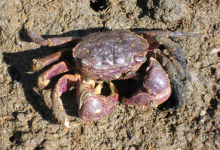 |
 |
Sesarma reticulatum and a burrow riddled creek bank where the cordgrass zone has been almost entirely eliminated.
|
One of the most striking aspects of the Cape Cod die-offs is the strong association between recreational fishing pressure and marsh die-off. Marshes near marinas, boat ramps or areas with high recreational fishing boat slip densities generally have extensive Sesarma-driven marsh die-off, while at inaccessible marshes with little recreational fishing pressure, Sesarma are present but do not lead to die-off.
We are currently critically examining the linkage between recreational fishing pressure and salt marsh die-off in New England, exploring mechanisms of the recovery of marshes once they have been entirely denuded of the cordgrass food source of Sesarma and tracking the spread of salt marsh die-off into Long Island Sound.
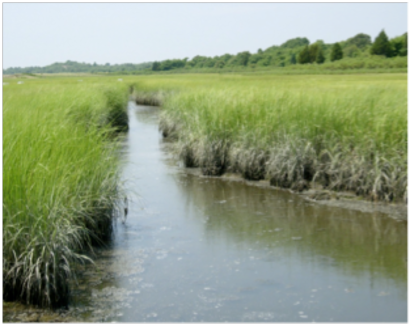 |
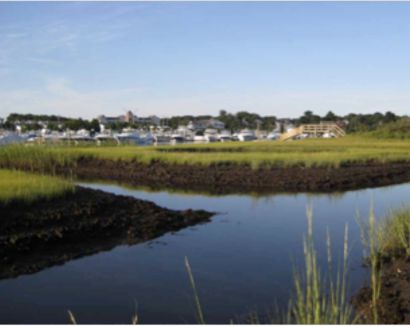 |
Healthy creek bank on left, Sesarma burrow riddled creek bank on right. Note the increased width of the mosquito ditches (originally 1m wide) affected by Sesarma-driven die-off.
|
References
Altieri AH, M. D. Bertness, T.C. Coverdale, N. C. Herrmann, C. Holdredge. 2011. A trophic cascade triggers collapse of a salt marsh ecosystems with intensive recreational fishing. Ecology 93: 1402-1410.
Bertness, M. D., C. Holdredge, and A. Altieri. 2009. Substrate mediates consumer control of salt marsh cordgrass on Cape Cod, New England. Ecology 90:2108-2117.
Coverdale T.C., N. C. Herrmann, A. H. Altieri and M. D. Bertness. 2011. Latent impacts: the role of historical human activity in coastal habitat loss. Frontiers in Ecology and the Environment 11: 69-74.
Bertness, M. D. and B. R. Silliman. 2008. Human Disturbance Driven Consumer Control of Salt Marshes. Conservation Biology 22(3): 618-623.
Holdredge, C., M. D. Bertness, and A. H. Altieri. 2008. Crab herbivory driven die-off of New England salt marshes. Conservation Biology 23:672-679.
|
 |
Positive Interactions in Community Organization and Conservation Biology

Cobble beach plant community in Narragansett Bay where the entire plant assemblage is obligately dependent on wave attenuation by cordgrass clones. |
For over 20 years work in my laboratory has focused on integrating the important role played by positive interactions in many natural communities into ecological theory. We have done this by working along steep intertidal physical gradients in salt marshes and rocky shores to experimentally examine how the nature of species interactions shifts across physical stress gradients. This work led to the development of the Stress Gradient Hypothesis (Bertness and Callaway 1994) that predicts that positive species interaction are most common under low physical stress due to associational defenses from consumers and under high physical stress due to group amelioration of physical stress. Incorporating positive interactions and particularly the positive effects of foundation species into coastal conservation and ecosystem-based management planning is a general interest in my laboratory.
I am currently working with Italian colleagues at the University of Sasari in Sardinia on the hierarchical organization of Sardinian sand dune plant communities and the shifting role of positive interactions across sand dune landscapes. Q He and I also recently published a concept and synthesis paper in Ecology addressing recent criticism of the Stress Gradient Hypothesis. |
References
Bertness, M. D. and R. Callaway. 1994. The role of positive forces in natural communities. Trends in Ecology and Evolution. 9:191-193.
Bruno, J., J.J. Stachowicz, and M. D. Bertness. 2003. Inclusion of positive interactions in ecological theory. Trends in Ecology and Evolution 18: 119-125.
Crain, CM and MD Bertness. 2006. Ecosystem engineering across environmental stress gradients: implications for conservation and management. BioScience 56: 211-216.
Altieri, A., B. R. Silliman, and M. D. Bertness. 2007. Hierarchical Facilitation of intertidal cordgrass-mussel bed communities. American Naturalist 169: 195-206.
Holdredge, C, A. H. Altieri, B. R. Silliman, and M. D. Bertness. 2011. Interactions among foundation species and their consequences for community organization, biodiversity and conservation. BioScience 61: 782-791. |
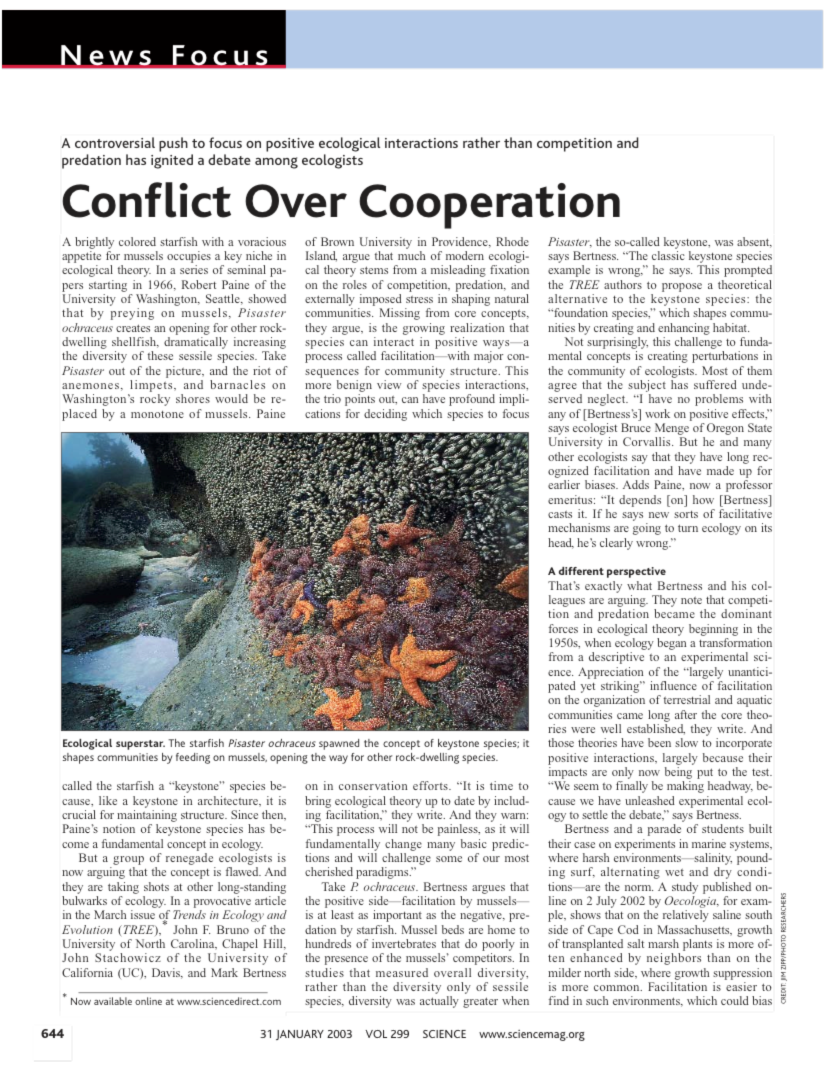 |
The Biogeography of Process and Pattern in Coastal Communities
I also have a longstanding interest in latitudinal patterns in the physical and biological processes that generate patterns in natural communities and using biogeographic process and pattern to predict the consequences of climate change. As a graduate student in Panama decades ago I did experiments that demonstrated that predation on rocky intertidal gastropods was strikingly higher in the tropics than in the temperate zone. More recently working with my former student Steve Pennings we have shown a latitudinal gradient in insect herbivory on salt marsh cordgrass and a parallel increase in the defenses of low latitude cordgrass. With former students Pat Ewanchuk, John Bruno and Jonathan Levine on rocky shores and salt marshes in New England we have experimentally elucidated latitudinal gradients in the nature of sessile neighbor interactions. In both systems the occurrence and importance of habitat ameliorating neighbors increase, while the occurrence and importance of competition decrease with decreasing latitude.
|
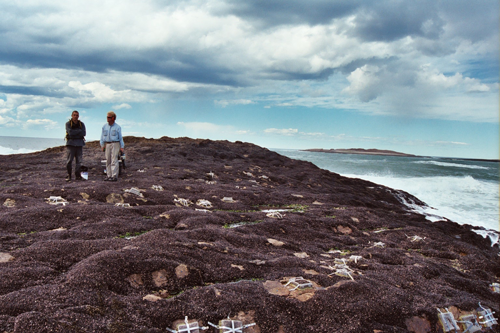
Patagonian mussel bed
|
References
Bertness, M.D., S.D. Garrity and S.C. Levings. 1981. Predation pressure and gastropod foraging patterns: a latitudinal pattern. Evolution 35(5): 995-1007.
Bertness, M. D., G. Leonard, J.M. Levine, and J. F. Bruno. 1999. Climate-driven interactions among rocky intertidal organisms caught between a rock and a hot place. Oecologia 120: 446-450
Pennings, S. C., E. Siska, and M.D. Bertness. 2001. Latitudinal variation in the palatability of marsh plants. Ecology 82: 1344-1359.
Bertness, M. D. and P. J. Ewanchuk. 2002. Latitudinal and climate driven variation in the strength of salt marsh plant competition and facilitation. Oecologia 132: 392-401.
Pennings, S. C., E. Selig, L. Houser, and M. D. Bertness. 2003. Geographic variation in positive and negative interactions among marsh plants. Ecology 84:1527-1538.
Gedan, K. B. and M. D. Bertness. 2009. Experimental warming causes rapid loss of plant diversity in New England salt marshes. Ecology Letters 12: 842-848.
|

